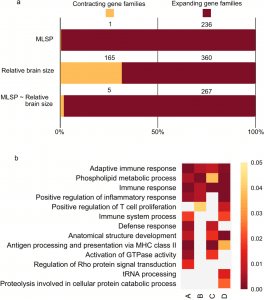Why do animals like cats often outlive dogs, or why do some mammals live dramatically longer than others? A new study points to a compelling evolutionary answer: larger brains and expanded immune systems are strongly linked to longer lifespans in mammals (Figure 1).

Figure 1: Significantly associated and functional annotation overrepresentation among gene families with size variations in mammals. Panel (a) shows the number of gene families expanding and contracting associated with MLSP; relative brain size; and MLSP corrected by relative brain size. (b) Gene ontology (GO) term enrichment analysis among the families significantly associated with several PGLS models. Coloured cells in each column represent significantly enriched GO categories after correction for multiple testing (Benjamini Hochberg). Colour intensity (towards purple) increases for smaller adjusted p-values. Individual columns show significantly enriched categories for (A) MLSP-associated families from PGLS model which has 46 species (r MLSP−associated families > 0, p < 0.05, n = 236), (B) relative brain size-associated families from PGLS with 59 species (r relative brain size−associated families > 0, p < 0.05, n = 360), (C) MLSP-associated families identified in 46 species in a PGLS model containing both MLSP and relative brain size (r MLSP−associated families > 0, p < 0.05, n = 267), (D) relative brain size-associated families from PGLS model that contains MLSP and relative brain size (r relative brain size−associated families > 0, p < 0.05, n = 184).
The research analysed genetic data from 46 mammalian species to investigate how genomic architecture—not just isolated genes—shapes lifespan potential.
Key Findings
- Brain Size and Longevity: Species with larger brains, such as dolphins and whales, tend to have much longer lifespans (up to 100 years) compared to species like mice, which live only a year or two.
- Immune Gene Expansion: Longer-lived mammals showed greater expansion in gene families associated with immune functions—suggesting that immunity plays a foundational role in sustaining longevity.
The researchers evaluated maximum lifespan potential (MLSP)—the maximum recorded lifespan for each species—and matched this with genomic features. They found:
- Expanded immune gene families were consistently present in longer-lived mammals.
- These immune genes likely support:
- Clearance of damaged or aging cells
- Tumour suppression
- Infection control
- Lifespan is shaped not just by mutations in specific genes, but by broad genomic shifts such as gene family duplication and expansion.
This suggests brain size and immune complexity evolved in tandem—larger brains offering cognitive survival advantages, and immune robustness providing the biological support for a longer life.
The study offers a powerful reminder: longevity isn’t just luck—it’s written into the genome. Understanding how brain function and immune resilience have co-evolved may help unlock strategies to extend healthy lifespans in humans and other animals.
Journal article: Huseyin. K., et al., 2025. Maximum lifespan and brain size in mammals are associated with gene family size expansion related to immune system functions. Scientific Reports.
Summary by Stefan Botha










